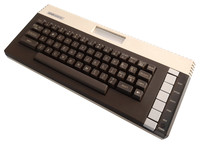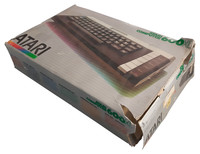Atari 600XL
| Home > Browse Our Collection > Computers > Atari > Atari 600XL |
|
The new designs for the Atari 8 Bit range, the Atari 800XL and 600XL, were announced at the 1983 Summer CES, they were to replace the aging look of the Atari 800 and 400. Both were very large machines, and were expensive to manufacture. Atari needed to counter Commodore's aggressive price drops. The machines had Atari BASIC built into the ROM of the computer, instead of being loaded in by a cartridge, and there was now an improved Parallel Bus Interface (PBI) at the back that allowed external expansion. This universal socket allowed tape drives and Disk drives to be connected, and the machines retained one cartridge slot of the original machines, to load in games and software. There was no longer need for the BASIC cartridge slot of the previous computers. Carts were no longer kept inside the computer, the slot was now on the top of the machine. There was also a printer port and a DIN Parallel one too. Two joystick ports are on the right hand side. The machine looked similar to the 1200XL, which had been a disaster at retail and also in technical terms, meaning that backwards compatibility with the earlier machines was seriously compromised. The faults were rectified by the 800 and 600XL computers. The name 600XL is thought to have originally meant to be half of the 1200XL. The 600XL has a full travel keyboard, and replaces the flat membrane keyboard of the 400, it has been said that the 400 was more aimed at children, therefore needed a flat keyboard so that drink and food could not get inside the machine, but it is far more likely that cost was the major factor in using it. Unfortunately, along with the Atari 800XL, the 600XL suffered chronic stock and parts shortages, and the price could never get anywhere near the Commodore competition, even being raised at one point. This situation was also not helped by the identity crisis the machines had always had. The Atari board wanted the machines to be in the business sector, but companies like Apple had killer business Apps like VisiCalc, the top programme for the Atari computers had been Star Raiders, a game, this left Atari with a problem in that their own console range was in direct competition with their computers. The video game crash in 1983 meant this was no longer a problem as the console market had imploded, but by now the C64 had a great library of games, and was also set up for business use. The 600XL is a very small micro, less than half the size of the 400, and has a much narrower back than the 800XL, due to it having only 16K of RAM compared to the 64K of the 800XL. The original 800 had 48K of memory. 16K was the maximum amount of RAM available to the Atari 400. The small amount of memory was a hindrance, now in the age of machines with far more RAM, but it was considerably cheaper than the 800XL. In the previous 5 years the Atari 8 Bit range had released a great selection of arcade titles that ran on the 400, so it still has relevance for retro gamers. The machine can actually be modded for 64K, by swapping a couple of chips, and soldering in a couple of wires, which effectively makes it an Atari 800XL. The machine also had a RAM Expansion unit released, the Atari 1064, this is now a very rare add on, that bypassed the internal 16K of RAM, replacing it with 64K, the unit only worked on the 600XL, as the ports of the 800XL would be covered. The Atari 8 bit family were available from 1979 to 1992, and were redesigned again in 1985 as the Atari 65XE and 130XE, these had 64K and 128K respectively, and were styled to match the new 16 bit Atari ST. Although never able to challenge Commodore the range still sold in significant numbers, especially in the USA and enthusiasts today are still producing many home brew titles for fans of the machines. Manufacturer: Atari Comment on This Page Atari 600XL Manuals:
Magazines RELATED to Atari 600XL in our Library
Other Systems Related To Atari 600XL:
This exhibit has a reference ID of CH64076. Please quote this reference ID in any communication with the Centre for Computing History. |
Click on the Image(s) For Detail
|














